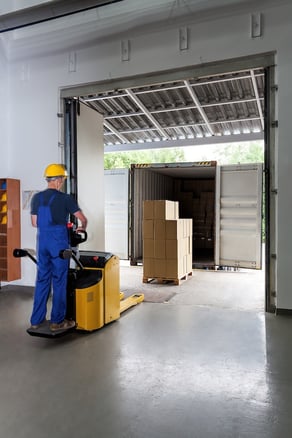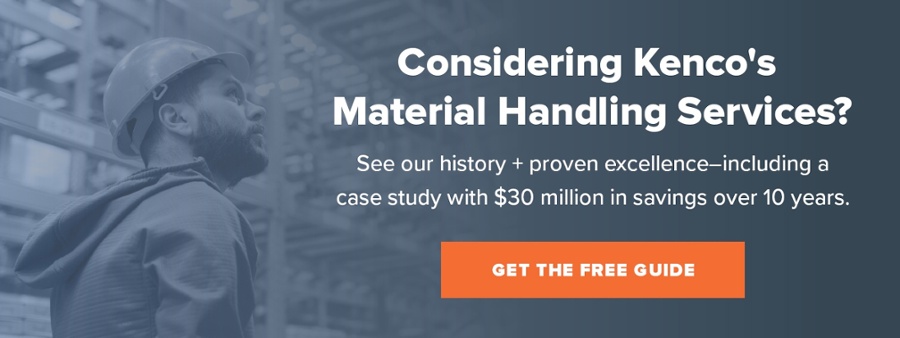
Choosing the right forklift for your operation can be a difficult decision. In addition to choosing between electric or gas lifts, you also need to decide whether a sit-down or stand-up forklift is the better option for your specific needs.
At first, you may lean one way or the other simply because of your personal comfort and experience––if you’ve been in the forklift seat before. But as a leader in the warehouse, there are far more differences to weigh before you choose how to outfit your fleet: 6 main differences, to be more precise!
Let’s walk through the key differences between a sit-down and a stand-up forklift, then launch into the other considerations you’ll need to take in before deciding which is right for your space.
Differences Between a Sit-Down and Stand-Up Forklift

In a sit-down forklift, the operator is seated, typically facing forward. To operate in reverse, the operator twists their upper body in the seat to see the space behind the lift. In a stand-up forklift, the operator is on their feet, and they may simply turn around or twist their entire body to see behind them.
Stand-up forklifts are usually operated with a series of levers that control the forward and reverse motion, as well as braking. Sit-down forklifts typically have a wheel, similar to the steering wheel in a car.
Beyond these fundamental differences, sit-down and stand-up forklifts have other differences that make them more or less suitable for a specific environment. These differences can affect the productivity and efficiency of the operation, as well as the operator’s comfort and safety.
To help you evaluate the differences in the categories of forklifts so you can make the optimum decision for your environment, we’ve created this handy checklist comparing the 6 key differences:
1. Operator On/Off Frequency
OSHA regulations require companies to protect their employees from known hazards, and failure to wear a seatbelt is hazardous. Employees are required to buckle their seatbelts before operating a sit-down forklift, so if the operator is moving on and off the forklift frequently during a shift, a sit-down forklift may adversely affect productivity.
A stand-up forklift enables the driver to get on and off quickly and easily, which may increase productivity.
2. Operator Comfort
 If the operator is on the forklift for extended periods, a sit-down lift may help to prevent fatigue, increasing operator comfort, and safety. If the operator is on and off frequently, a stand-up forklift will help optimize productivity without affecting comfort or safety. Consider the duration of use when choosing between stand-up and sit-down forklifts.
If the operator is on the forklift for extended periods, a sit-down lift may help to prevent fatigue, increasing operator comfort, and safety. If the operator is on and off frequently, a stand-up forklift will help optimize productivity without affecting comfort or safety. Consider the duration of use when choosing between stand-up and sit-down forklifts.
Another great idea to consider when deciding between a sit-down or stand-up forklift is the preference of the end user. A great way to encourage adoption is to get the opinion of the operator. The operators in the warehouse have the experience of what has worked historically and what has not worked. Getting the buy-in from the operators on the forefront could save a lot of resistance on the backend.
3. Maneuverability
For many warehouses, space is at a premium. Some warehouses have narrow aisles and little room to turn around or maneuver material handling equipment. A sit-down forklift often has a wider wheelbase and a larger turning radius than other forklift designs, making them difficult to operate efficiently in small spaces.
With their smaller turning ratios and maneuverability, a stand-up forklift may be the better choice in space-constrained environments or those with narrow aisles.
4. Your Typical Operating Environment
Consider the environmental conditions of your operation. Sit-down forklifts often have a lower profile than stand-up units, making them a better choice in environments with overhead obstructions. A sit-down unit also operates more easily on steep grades, so if your units must navigate steeply sloped floors or worksites, a sit-down unit will be more practical. Sit-down forklifts are often safer on slippery surfaces or on surfaces likely to be covered with loose gravel or spilled industrial materials. Long travel distances also lend themselves to sit-down forklifts.
Even with these conditions, a stand-up forklift may be the right choice because of its maneuverability. In congested areas with complex traffic patterns, a stand-up lift offers distinct advantages.
However, the most important consideration is operator safety, so be sure to consider the effect of the environment on the operator as well as on productivity.
5. Site Safety Requirements
Like we have mentioned before, in a sit-down forklift, operators must buckle the seat belt every time they sit down, which can adversely affect productivity over time. The seat belt helps to ensure operator safety during the workday, but in an emergency, a stand-up forklift allows the operator to dismount from the vehicle quickly. Those few seconds may provide a margin of safety for the operator.
6. Operator Learning Curves
Since sit-down forklifts operate much like a car, operators usually require less training than with other lift equipment. Stand-up lifts often operate using a series of levers and controls. The controls may vary between manufacturers and individual forklift models, so that these forklifts may require more operator training.
While the individual operator training may not amount to more than a few hours or days, consider the number of operators and your employee turnover, since each employee must undergo training and safety instruction.
To Sum It Up
There are a number of factors associated with the choice of a sit-down or stand-up forklift. Many of these factors affect productivity or operator comfort, but the primary consideration should always be operator safety. Before making your equipment decision, consider the factors in this checklist to guide you to the right choice for your unique environment.
Regardless of your decision on the type of forklift, you need to ensure that your team follows recommended maintenance schedules and procedures for all your MHE equipment. This can be a complex task in and of itself, but you can only expect peak ROI from your MHE investment if the equipment is operating at peak performance.
That’s why many companies turn to a third-party material handling equipment service provider for quality, cost-effective maintenance. To learn more about Kenco’s Material Handling Services and the benefits our customers enjoy, view our eBook to see our history and case studies of cost-savings and efficiency.



